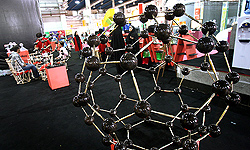Performance Model of Biomolecules in Magnetic Fields Revealed by Scientists

Iranian researchers at Malek-e Ashtar University of Technology and Tarbiat Modarres University managed to discover a meaningful model for performance of biomolecules in magnetic fields by studying the effects of magnetic nanoparticles on the enzyme activity of Flavobacterium, modified with magnetic nanoparticles.
Cell stabilization is the physical holding or connection of a cell in a particular place in a way that it can be used repeatedly and continuously. Unique and special properties of magnetic nanoparticles are the reason for their wide applications in magnetic modification of cells and biomolecules. The cells can be stabilized by using either external or internal magnetic fields. Cell stabilization method has been used in biodegradability, removal of undesired materials, material production, and fabrication of biosensors. This technology can also be used in the designing of the new generation of detection kits that are based on the connection of biomolecules and magnetic nanoparticles.
In this research, Flavobacterium was firstly magnetically modified by using magnetic nanoparticles. Then, the magnetically modified bacterium was stabilized with internal and external magnetic field, and the effect of nanoparticles and the stabilization process method on biological performance of the magnetically modified bacterium was studied afterwards.
The main purpose of the research was to study the effect of magnetic nanoparticles on enzyme activity of Flavobacterium (as a model), and the enzyme stability of the magnetically modified bacterium was evaluated. Results of the research showed that stabilization with external and internal magnetic field increased the enzyme activity of the bacterium stabilized at high and low pH values.
The results of the research have been published in December 2010 in Biocatalysis and Biotransformation, vol. 28, issue 5-6, and also in January 2012 in Bioresource Technology, vol. 104, pp. 6-11.







